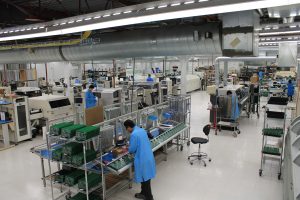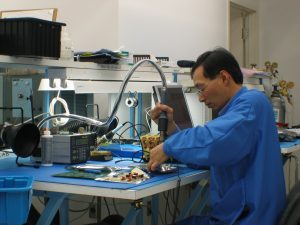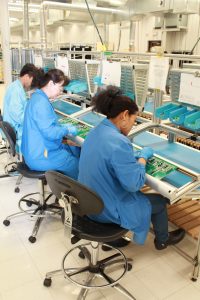
Electronics test and measurement – Travelling in partnership
By By George Henning, president, OCM Manufacturing Inc.
Electronics Production / Materials Test & Measurement Contract Manufacturing Engineering measurement test testEvery client engagement is a journey. As a contract electronics manufacturer, our destination is a final product that meets or exceeds the quality, functionality, performance, and cost requirements set by the customer. There are several stages on that journey and one of the most important is test and measurement. 
Test and measurement: it sounds precise and scientific, doesn’t it? Yet, it is never a perfect science. It’s often impossible to test everything we’d like to test, for a variety of reasons: time, cost, and access to test nodes being the primary of those. And, issues we discover during test aren’t always 100% resolvable for the same reasons.
Ideally – but rarely – a test plan is part of the product’s design. With so many other competing considerations during early design – particularly the design of innovative and time-sensitive products – designers don’t often have that luxury.
For that reason, we often deploy test and measurement techniques after the design is complete. In that situation, test may be more difficult, more costly, or more time consuming than if planned/implemented earlier. Design iteration may also be necessary to support test.
One electronic product’s journey
Let’s follow the journey of a high-end, complex electro-mechanical assembly. The design – which is nearly complete when we receive it – calls for:
* two circuit card assemblies (CCAs), both densely populated on both sides
* cable harnesses
* batteries
* firmware programming
* bench testing
* potting
* ultrasonic welding
Due to the nature of the design, the final product can be fully tested as a unit only after final assembly, when the CCAs are mated and connected to power. A staged test approach will be necessary to ensure that the individual boards are defect-free and fully functional prior to final system assembly.
Milestone 1: prototype
Once we have built the prototypes for this product, we put the CCAs through several reviews, including AOI, QA/QC, and a visual inspection. The source of most deficiencies that we discover are related to component footprint design on the PCB, design of mechanical components and fit, or thermal issues (warping/imbalance or thermal relief issues).
We also find design for manufacturing (DFM) efects, including missing fiducials; placement choices that will be costly and error prone; and, difficult assembly choices.
That may sound like a long list, but it is not atypical. We sit down with the customer to review our findings and provide recommendations for changes that will address the identified issues.
Testing is typically completed by the design engineer in his or her lab using in-house instruments and jigs/leads. The engineer’s detailed understanding of the design is employed to validate the design work, assembly, and proper function of components.
As with any engineering process, there are trade-offs. Through discussion and planning, we come to an understanding about what must change, what can change, and what will be sacrificed. Our client’s concerns are tightly tied to its end-customer expectations of delivery, cost, and performance.
As a team, we agree that test (perhaps Flying Probe Test (FPT) or functional) of the individual CCAs prior to final assembly and final test will be the most effective test approach.
Milestone 2: Flying Probe Test implementation
We implement a plan to develop FPT tests for subsequent builds of the CCAs. To ensure test access, we analyze the PCB designs for access to nets. We discover that many nets are not accessible so test coverage will be low unless costly fixtures and connector interfaces are implemented. Even so, some nets will still be inaccessible with this approach. Given this, the designer elects to implement changes to allow for more ready access.
We produce a batch of the new CCAs, assemble, and test them using the newly created FPT programs. These tests reveal defects on the individual CCAs: a part is out of spec and some solder joints are inadequate due to solderability of materials. These defects are localized by the FPT and readily repaired without debug efforts. Subsequent FPT retest reveals that all issues are resolved. 
Stage 3: limited production run
With altered designs in hand, we complete a limited production run. Once again, our manufacturing team assesses the CCAs using AOI and manual inspection. This process is now faster in comparison to the first round, due to resolution of the earlier-identified deficiencies.
Our customer performs in-house testing on the completed CCAs and, once satisfied, decides to proceed with production. With greater volume, the design engineer now realizes it will take a long time to validate these on the design bench, and requests production test development as well.
Stage 4: production, assembly & test
With the individual component cards assembled and bench tested, we move on to final product assembly, which includes mating the CCAs, soldering the battery connections, and making connections to connectors on the chassis. With access to the chassis connectors, we can now proceed with final test.
Stage 5: ongoing production
Final assembly yields increase and the bone pile shrinks, no longer tying up resources and technical expertise for debugging.
We use data from the FPT to rapidly correct processes when failures do occur. Rework at this stage is quick and requires no debug. Yields are high at final test and orders are completed on time and in full quantities. This gives our customer – and theirs – a high level of confidence in the quality and performance of the product.
Travelling in partnership
In contract manufacturing, two teams of people must come together: the CM’s team and the client’s team. The client provides the vision and expertise to develop and sell the product. The CM provides the manufacturing and test expertise and infrastructure to bring that vision to production reality. Ideally, both teams can work closely from early in the design phase. More often than not, they must work together to solve problems well after designs are hardened.
As I said at the outset, test and measurement is not a perfect science. Much like engineering, it is a game of trade-offs and problem solving within usually very tight parameters.
Yet, by working together, CM and client, we strengthen base designs, maximize efficiencies, and provide as much confidence as possible that the product will meet and or exceed expectations.

